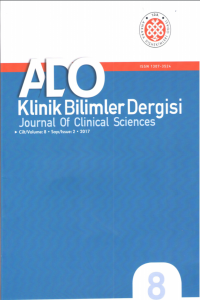Temporomandibuler Eklem Manyetik Rezonans Görüntülerinde Efüzyonun Değerlendirilmesi
Efüzyon, TMD, Dejenerasyon
The Evaluation of Effusion in Magnetic Resonance Images of Temporomandibular Joints
Effusion, TMD, Degeneration,
___
- Helms CA, Richardson ML, Moon KL, Ware WH.: Nuclear magnetic resonance imaging of the temporomandibular joint: Preliminary observation. J Craniomandibular Pract; 2:219-24, 1984.
- Roberts D, Schenk J, Joseph P.: Temporomandibular joint: Magnetic resonance imaging. Radiology 155:829-830, 1985.
- Harms SE, Wilk RM, Wolford LM, Chiles DG, Milam SB.: The temporomandibular joint: Magnetic resonance ima- ging using surface coils. Radiology 157:133-136, 1985.
- Katzberg RW, Bessette RW, Tallents RH.: Normal and ab- normal temporomandibular joint: MR imaging with surfa- ce coil. Radiology 158:183-189, 1986.
- Gynther GW, Holmlund AB, Reinholt FP: Synovitis in in- ternal derangement of the temporomandibular joint: Cor- relation between arthroscopic and histologic findings. J Oral Maxillofac Surg 52: 913, 1994.
- Javier B, Noto AM, Herman LJ, Mosure JC, Burk JM, Ch- ristoforidis AJ. Joint efusions: MR imaging. Radiology 158:133-137, 1986.
- Isberg A, Isacsson G, Johansson A-S, Larson O: Hyperp- lastic soft tissue formation in the temporomandibular joint associated with internal derangement. Oral Surg Oral Med Oral Pathol 61:32-8, 1986.
- Murakami M, Nishida M, Bessho K, Lizuka T, Tsuda Y, Konishi J: MRI evidence of high signal intensity and tem- poromandibular arthralgia and relating pain. Does the high signal correlate to the pain? Br J Oral Maxillofac Surg 34:220-224, 1996.
- Westesson P-L, Brooks SL: Temporomandibular joint: Re- lationship between MR evidence of effusion and the pre- sence of pain and disk displacement. Am J Roentgenol 159:559-563, 1992.
- Güler N, Uçkan S, Imirzalioğlu P, Açikgözoğlu S.: Tem- poromandibular joint internal derangement: relationship between joint pain and MR grading of effusion and total protein concentration in the joint fluid. Dentomaxillofac Radiol.34(3):175-81, 2005.
- Yano K, Sano T, Okano T.: A longitudinal study of mag- netic resonance (MR) evidence of temporomandibular joint (TMJ) fluid in patients with TMJ disorders. Cranio. 22(1):64-71,2004.
- Sano T, Westesson P-L: Magnetic resonance imaging of the temporomandibular joint. Increased T2 signal in the retrodiskal tissue of painful joints. Oral Surg Oral Med Oral Pathol 79:511-516, 1995.
- Adame CG, Monje F, Munos M, Granizo RM: Effusion in magnetic resonance imaging of the temporomandibu- lar joint: A study of 123 joints. J Oral Maxillofac Surg 56:314-318, 1998.
- Westesson P-L, Paessani D: MR imaging of the TMJ. Dec- reased signal from retrodiscal tissue. Oral Surg Oral Med Oral Pathol 76:631-635, 1993.
- ISSN: 1307-3540
- Yayın Aralığı: Yılda 3 Sayı
- Başlangıç: 2006
- Yayıncı: Ankara Diş Hekimleri Odası
Füzyon: Bir Literatür Güncellemesi
Direkt Kompozit Rezin Veneerlerle Diastema Kapatılması
Gamze MANDALI, Arzu Zeynep Yıldırım BİÇER, Burhan KONAKÇI
Beyaz Nokta Lezyonlarının Teşhis ve Tedavi Yöntemleri
Meltem Derya AKKURT, Günseli Güven POLAT, Ceyhan ALTUN, Feridun BAŞAK
Seçil KARAKOCA NEMLİ, Duygu BOYNUEĞRİ
Temporomandibuler Eklem Manyetik Rezonans Görüntülerinde Efüzyonun Değerlendirilmesi
M Ercüment ÖNDER, Hakan H TÜZ, Reha Ş KİŞNİŞCİ, İbrahim Tanzer SANCAK
Aşınmış Dişlerde Protetik Yaklaşımlar
Gamze MANDALI, Arzu Zeynep Yıldırım BİÇER, Zeynep BULUT, Hasan ÜLGEN
Alper ÖZER, Pınar ALTINCI, Gülşen CAN
Seçil KARAKOCA NEMLİ, Bilge Turhan BAL, Handan YILMAZ, Cemal AYDIN, Şükran YILMAZ
İntraoral İmplant Planlamasında Üç Boyutlu Görüntüleme Tekniklerinin Kullanımı
Merve BANKOĞLU, Seçil Karakoca NEMLİ
İmplant Kaybı, Risk Faktörleri ve Yüzeyin İmplant Kaybına Etkisi
